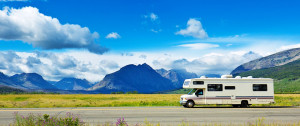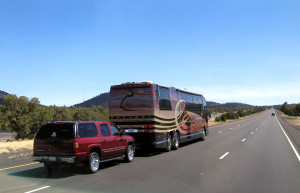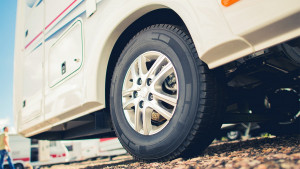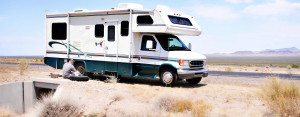A study that was conducted by United Tires suggested that 44.9% of Americans have had a tire blowout on them when driving.
RVs are at particular risk of suffering from tire blowouts due to the additional load weight that they carry and the varied terrain they are often driven on. RV owners should therefore be extra diligent in their tire care compared to regular vehicle drivers. For more tire tips and tricks for your before you hit the road. Be sure to reach out to our friends at United Tires and contact them here
Here are some steps that you can take to reduce the possibility of tire blowouts happening on your road trips.
Do Not Exceed Your RV’s Gross Vehicle Weight Rating
An RV’s Gross Vehicle Weight Rating (GVWR) is the maximum loaded weight that it can carry without putting undue pressure on its axles, brakes and tires. You should find this information in your RV’s driver’s manual.
When an RV is overloaded, its tires are forced to withstand a weight that is more than what it was intended to handle. Prolonged exposure to this excessive weight will lead to the tires blowing out.
It’s a good idea to take your RV to a weighing station before you start your trip so you can check if it’s still within its GVWR when fully loaded. Please note that you should have all the passengers and things that you will bring on your trip inside the RV to get as close as possible to its full GVWR.
If you intend to tow a trailer with your RV, you need to take a couple of other weight limits into consideration:
- Gross Trailer Weight Rating (GTWR) – the allowable weight that a trailer can carry. This covers both the trailer itself and all its contents.
- Gross Combined Weight Rating (GCWR) – the maximum weight of both your RV and the towable vehicle that your RV can handle without posing any danger.
To minimize the chances of a blowout occurring on either your RV or trailer tires, you want to ensure your vehicles are below these maximum weights.
Store Your RV Away From Direct Sunlight to avoid the dry rotting of tires
Tires degrade as they age. Exposure to direct sunlight for an extended period of time makes tires degrade much faster.
The UV rays from the sunlight strip the anti-weathering agents that protect the tires from rapid deterioration. This causes the rubber in tires to become much more brittle and therefore prone to blowing out.
You should therefore store your RV indoors to avoid the premature deterioration that the sunlight causes to its tires.
Ozone also has the same detrimental effect on your tires.
You should keep pieces of equipment that produce ozone away from your RV when storing them inside a garage. This includes generators and car battery chargers.
If parking your RV outdoors is your only option, it is best to keep them in a covered area so its tires are rarely in direct sunlight.
Do Not Use Tires That Are Older Than Five Years
Tires will age over time no matter how often they are used or not. Therefore, you should replace tires that are more than five years old.
You can determine your tire’s age by looking at the last four digits embossed on the innermost ring of letters/numbers of its sidewall.
These numbers represent the week and the year your tire was manufactured. The first two numbers are the week and the last two are the year.
If the last four digits are “0520” for example, the tire was made in the fifth week of the year 2020. Remember what year your tire was manufactured in, and consider replacing it when it gets to five years old, regardless of whether there are any other obvious issues with your tires or not.
Keep Your Tires Properly Inflated
Driving on underinflated tires can also cause blowouts. The increased flexibility in underinflated tires shifts pressure away from the tread of the tire to its sidewall. As the latter part of the tire was not built to take excessive pressure, this can blowout if put under too much strain.
To keep your tires at their correct pressure, you should always carry a tire pressure gauge and tire pump on road trips.
Check your tire pressure level with a gauge every 2,000 miles and pump them up if they fall more than 5% under their recommended inflation levels (as stated in the RV’s driver’s manual).
Modern RVs are now equipped with automatic tire pressure monitoring devices. However, they are not reliable when it comes to catching slow punctures that may cause your tires to become underinflated without you noticing. A manual check is still therefore required for optimal tire performance.
Do Not Let Your Tires Overheat
Tires overheat due to excessive amounts of friction between the tires and the road that they are driving on. This overheating can be exacerbated by hot weather conditions, driving on underinflated tires, and driving at high speeds. Driving for long distances on highways can therefore make your tires particularly susceptible to this type of blowout.
As the heat builds up in tires, pressure also builds up. This will lead to a blowout when the tire can’t hold the rising pressure anymore.
Therefore, you should take simple precautions to keep your tires from overheating such us:
- Keeping your tires properly inflated
- Using low rolling resistance tires if you’ll only be driving in paved roadways
- Taking a 30-minute break every three hours of driving to let your tires cool down
Taking these precautions is even more important if you are driving on a hot day (over 90 degrees Fahrenheit).
Conclusion
Tire blowouts are just one of the most common issues that new and experienced RV owners might face during their trips.
Aside from the technical problems though, RV journeys will also be riddled with challenges that will test life skills.
In this case, our blog that is filled with RV stories and hacks might help and make your RV adventures easier and more fun.
——————————————————————————————————-
This article was contributed by Mike Skoropad. Mike is the CEO of tire retailer United Tires






